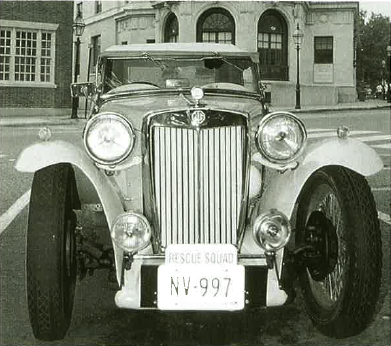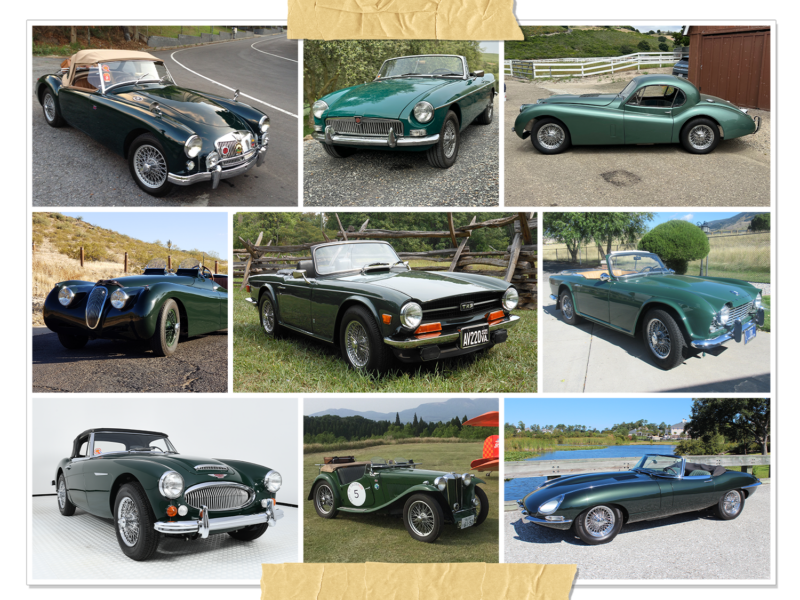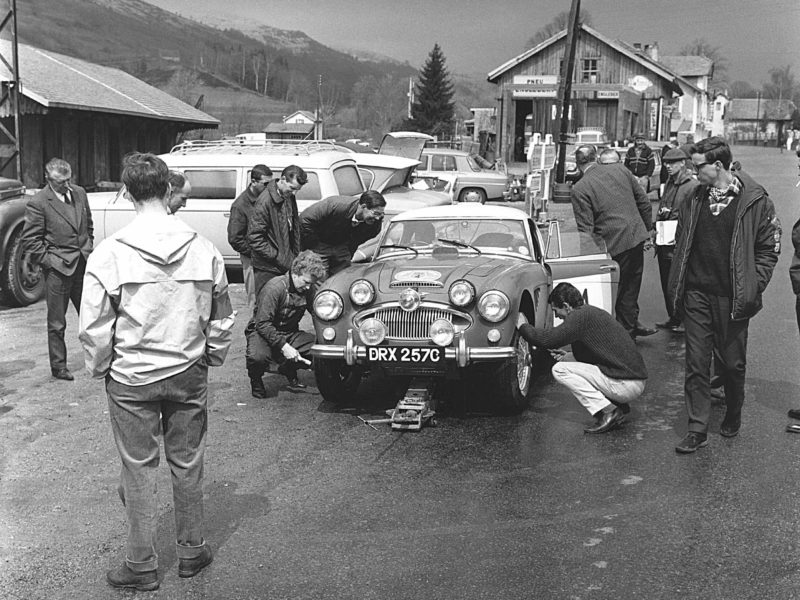To read earlier parts in this series, click the following links:
In which Sam Bennett continues to describe life and times at the MG factory in the early days.
By Marcham Rhoade
Pressed steel used to make the chassis for the MGs, and the bodies came from Carbodies of Coventry. As everyone knows, nothing was ever made at Abingdon—it was an assembly plant, pure and simple. However, from time to time, we did have to improvise or design bits and pieces to make them fit, and there were some very skillful people employed at the MG Car Company.
For example, there was a small paint shop separated by a partition from where the sheet metal workers were based, and the last job these chaps had to do when a car came off the line was to trim the bonnet (hood). From the bulkhead to the radiator, the bonnets were always oversize, so when the sheet metal workers got them, they had to be tailored to individual cars, mainly because they couldn’t guarantee the parallel lines of the body being accurate. They would trim them with tin snips and files, to suit each individual car as it came off the line.
At the bottom of the ramp was the “tyre” man, a chap by the name of Willis. He was only a little fellow and he used to put the tires on the wheels. He was always surrounded by inflated inner tubes, seeing whether they lost any pressure, and he would also respoke any wheels that needed attention from the service department. Willis had none of the modern tire fitters’ equipment with which we are so familiar today; just a set of tire levers polished like silver due to constant use. He had a board about three feet square with a dummy hub on it, and he’d get a tire and a tube and in a couple of minutes it was on the wheel. At this time the assembly line at Abingdon was a brick effort about 10” high, with a guide channel for the offside wheel. The workers pushed the cars along by hand, right up to the end of MG production in 1980. A shortage of wheels in my day was remedied by having dummy wheels made of wood, which could be fitted so that production was not halted.
After a while I was put to work in the units, the racing engine shop where I came in contact with Reg “Jacko” Jackson, Syd Enever, Billy Newnes, and a chap called Carter, who had the dirtiest job of all grinding out the cylinder heads until they shone like silver. I must have done a fairly good job here, for I was then sent on to the balcony to work on racing car assembly. This area was approached by a ramp leading up from the main floor of the shop. We worked in a place called the cage because it was surrounded by chain link fencing to keep out unauthorized visitors.
As I have mentioned before there were no such things as pits to get beneath the cars. We used to jack up the rear wheels and put them on wooden shoes, and then we would lift up the front with block and chains. The shoes ensured that the tail pipes, etc., didn’t catch the floor. For driving the base chassis around the works, each man had his own personal wooden seat which he would then clip on to the chassis. These seats had no backrest, so one couldn’t use the footbrake, and so we always used the handbrake which was compensated with the footbrake. In addition, you had your own two-gallon petrol tank with flexible pipe to provide fuel, and your own oil catching pan. This was to drain the oil, which in those days seemed to be very often.
Around the fence of the cage in the gallery were affixed all the garlands, numbers, and laurel leaves which had been won by the competition MGs prepared in the racing bay. They came from many exotic places, including Montlehery, Monte Carlo, the Mille Miglia, and many others, and provided a splendid display for distinguished visitors admitted to the racing shop. At this time I was working in the MG Q-type, of which only eight were made. They had dual petrol pumps and I was asked to put the petrol lines in, but I was instructed that on no account was I to drill the body of the car to fix them. At first I thought about fixing the lines to the floorboards, but eventually I designed and made some brackets which allowed me to lead the two pipes around on the inside of the body without drilling.
Speaking of the Q-type, I recall that one day a racing driver came along to collect his new Q and he brought along with him his riding mechanic. This particular driver was very disabled due to a race accident and he could not get into the car without a great deal of difficulty. We talked the situation over and without further ado, he cut part of the body away, leaving a big hole on the driver’s side. We then fixed him up with a broad leather strap, some 9” wide, to keep him from falling out of his seat when cornering—you might say this became one of the first ever safety belts. If I remember correctly, his name was Urqulines.
We got to know all the racing drivers of the time through working on their cars, and they used to spend many long hours with us in the workshops. George Eyston was, of course, a regular, very, very reserved, and he had a kind word for everyone he came in contact with. All the competition drivers who came to Abingdon were real gentlemen, and they frequently visited the works to collect their new MG car or to try their various seating positions. I recall E.R. Hall who was famous for his deeds at the Shelsey Walsh hill climb. He was a balding kind of man who came in one day and asked if we could fit twin wheels onto the rear axle of his MG specifically for his climbing events, and of course we did! Another time we fitted a device rather like a sunblind on the front of his radiator for quicker warm-up of the engine. This was operated by a wire leading into the cockpit. Hall eventually accumulated so much equipment for his cars in one corner of the factory that he was sent a strong letter asking him to remove it, or it would be dumped.
Nuvolari! Well, what can one say about him? I once asked Alec Hounslow what it was like to drive with Nuvolari and he replied, “It is unbelievable. He is so very quick and a master at the art of cornering. In fact, if you put a matchbox on the racing line of a corner, he would hit it every time he took the corner.” Hamilton, who came second to Nuvolari in the Ulster T.T., was another man who always took time out to talk to you. However, he was unfortunately killed in the Swiss Grand Prix of 1934. So, at one time or another, nearly every famous driver of the era came into the works, and it was my privilege to meet them all.
I remember preparing a J-type which either Hamilton or Black was to drive at the Ards Circuit in 1934. I was told by the foreman that I couldn’t go on holiday until the car was finished. I telephoned my girlfriend and told her that when I came up to Lancashire we would go to Ireland for our holidays. Little did she know that we would finish up sitting at Quarry Corner on the circuit to watch the race! You see, MGs get in your blood, and even on holiday you couldn’t leave them alone.
However, it was not all successes. There was one sad occasion when one of our mechanics was killed. We had three cars which went over to the Isle of Man for the Mannin Beg event. Held on public roads, this race drew thousands of spectators from the mainland. The roads were closed for the race and also for testing, at the completion of which the cars came back to the pits for any rectification needed, ready to go out the following morning for retest. The chief mechanic was informed that the car was ready and they started to prepare it around lunchtime. The driver was informed that he could retest the car the following morning, but he said, “We’ll test it right now.” They went out onto the open roads and unfortunately hit a taxi, the wheels of which were taken clean off. The MG overturned in a nearby field and the mechanic was fatally injured. It was a very sad moment for me to attend his funeral in Oxford.
Where was Cecil Kimber in all this, I hear you say? Well, we didn’t get to speak to him very much, but he was a real gentleman. He always wore a dark suit and a trilby hat, walking with the aid of a stick due to his disability. I can still recall the way he used to walk into the shop—even then, he was Mr. MG. It was a great pity that he lost his life in the train crash as he did. I think he would have gone on to even greater things. You know, in many ways Frank Williams (of Formula One fame) reminds me a lot of Cecil Kimber.
There were only two men detailed for tuning the racecars, and there was no sophisticated equipment…not even a stethoscope! Tuning was carried out using a long screwdriver, which you placed on the engine with the wooden handle against your ear. All the cars were hand-tuned from years of experience, and tuning was a real art. The only problems we encountered were with cars that went abroad, where, the tuning setup at Abingdon was knocked out by different temperatures, altitudes, etc., and sometimes cars had to come back to the factory for rectification.
We didn’t have great deal to do with the Wilson Preselector gearboxes, the experts from Wilsons being more adept at this. Any faults with the Wilsons which we did find, such as metal fatigue or cracks, were identified with a red label and returned to the factory for rectification. I recall on one occasion a K3 coming in on which the preselector had accidentally been passed through into reverse, and the clutch then let in! It twisted the propshaft just like a woodscrew, pulled the rear axle, snapped the spring link, and damaged the driver’s legs. This will give you an idea of the enormous power the K3 possessed! Following this unfortunate mishap, a means of checking was devised so there was no fear of another driver accidentally engaging reverse in the future.








'Abingdon in the 1930s, Part III' has no comments
Be the first to comment this post!